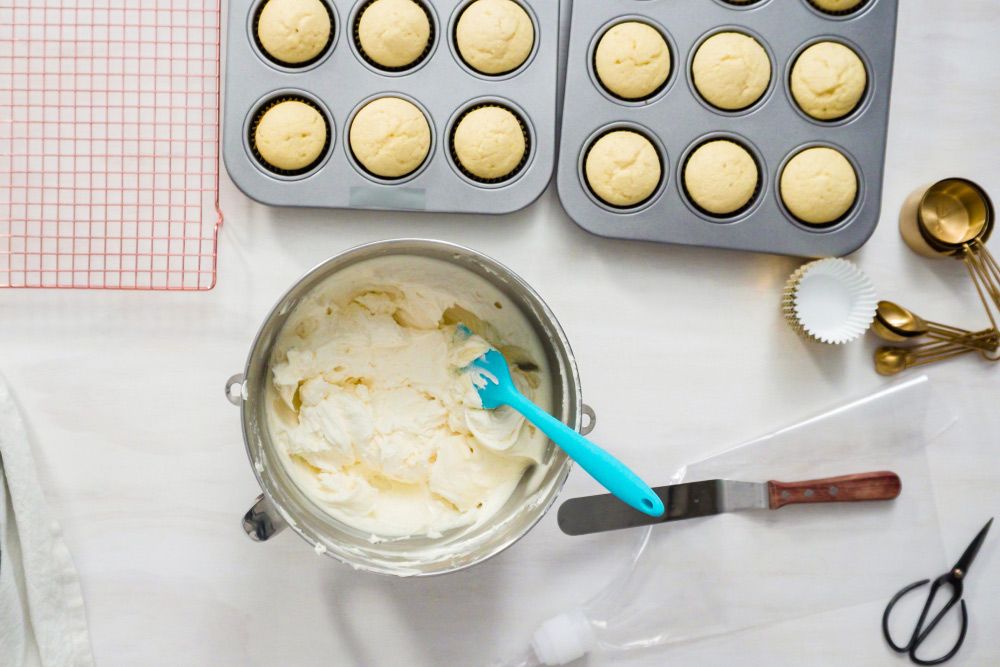For some people, cakes are incomplete without a layer of frosting on the top. While there are many types of frosting, the classic buttercream frosting recipe remains a crowd favorite. It is not only easy and quick to make but also extremely versatile in the sense that it goes well with most cake flavors. What’s more, buttercream frosting has a rich and creamy texture, which makes decorating the cake much easier.
Tips to make buttercream frosting
There are several types of buttercream, such as American, Russian, French, Swiss Meringue, German, and Italian. Of these, American buttercream is the easiest to emulate at home. Regardless of the variation, all kinds of buttercream frosting can be made perfectly using simple tips and techniques.
Use room-temperature butter
Ensuring the butter is at room temperature is a key tip to achieving perfect buttercream frosting consistency. Butter can be whipped quite easily at room temperature, resulting in a light and fluffy buttercream. Pulling out the butter from the fridge around one hour before baking should be enough to bring it to room temperature.
One can use the poke test to understand if the butter is ready to whip. All one must do is press a clean finger into the butter. If one can squish a finger through without causing the butter to lose shape, the butter is at room temperature and ready to whip.
In emergencies, a microwave can be used to soften frozen butter. That said, one must ensure there’s no metal-based wrapping on it before trying this. One can place the stick of butter in the microwave and heat for 5 seconds. This step must be repeated three times while turning the butter so that the other sides are heated as well.
Use a mixer for mixing
Those who have a stand mixer can put it to use when making buttercream! Whisking using a hand can take a lot of time and effort, which could be invested in other tasks in the kitchen.
There are two popular attachments for stand mixers that can be used for making buttercream: the whisk and the paddle. The paddle is ideal for whipping a smooth buttercream (especially American buttercream) without beating in too much air. On the other hand, the whisk is great for making emulsified buttercream (such as the Swiss or ermine varieties).
Whip the butter before adding sugar
One shouldn’t rush to add sugar to the butter. It’s important to first whip the butter thoroughly until it reaches a light and fluffy consistency and assumes a pale color. Whipping infuses air into the butter, ensuring a smoother frosting. When it’s finally time to add sugar, one must remember a few things.
- Add the sugar in two or three batches instead of all at once. This will ensure even distribution without creating a cloud of sugar.
- Mix the butter and sugar on the lowest setting (or on pulse) so it incorporates better.
- Use a mixer shield (or create a makeshift one with a paper towel) to prevent sugar from flying out of the mixer.
For traditional American buttercream, it is recommended to use a ratio of 1 part butter to 2 to 3 parts of sugar (depending on one’s taste and consistency preference), along with a splash of heavy cream or milk. This buttercream frosting ingredients ratio will ensure proper texture and taste.
Use good-quality vanilla
Buttercreams also require a little flavor, and vanilla, by far, remains the most popular choice for this. Since vanilla will be the primary agent of flavoring in the buttercream, it is recommended to look for a good quality variant.
Here, there are two options: vanilla extract or vanilla bean paste. The paste will leave small flecks of vanilla throughout the finished frosting, so it is better to use vanilla extract for a clean, white finish.
Add a splash of heavy cream
Adding heavy cream is another big secret to making a smooth and fluffy buttercream frosting. The heavy cream helps dissolve the sugar, giving the frosting a smoother, creamier finish. If one does not have buttercream on hand, a splash of milk could do the trick, too.
Add a touch of purple gel food coloring
If the buttercream looks too yellow, it is easy to neutralize it using color theory. Purple stands on the opposite side of yellow on the color wheel and can be used to tone it down. All one has to do is add the tiniest amount of purple gel food coloring.
Instead of using a dropper or a spoon, one can take a toothpick, lightly dip one end of it in the coloring, and mix this in with the buttercream to get a paler finish. Remember, adding too much purple food coloring could result in a grayish or purple finish, so be mindful of the quantity used.
Troubleshooting buttercream frosting
There’s no need to worry if something goes wrong while making the buttercream. Most errors can be fixed easily.
- If the finished cream is too runny, add more sugar or place it in the freezer for a few minutes. If it is too thick, add a little more liquid.
- To avoid a grainy texture, use powdered sugar instead of granulated sugar. If the grainy texture persists, warm the mixture slightly while mixing.
- If the buttercream has split, place it over gentle heat and continue mixing until everything evens out.
